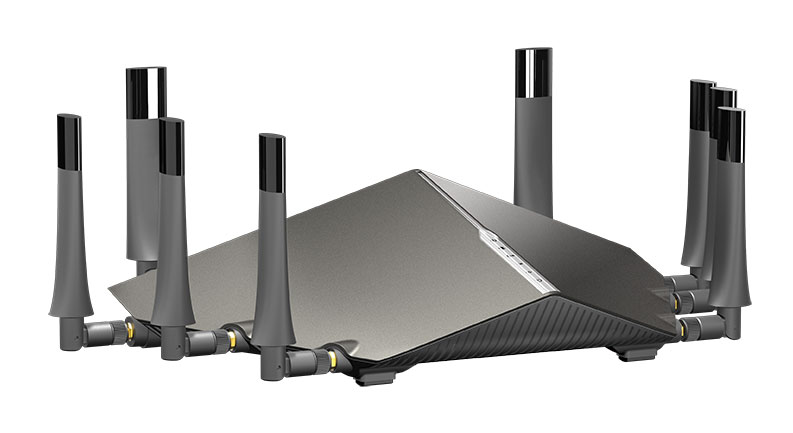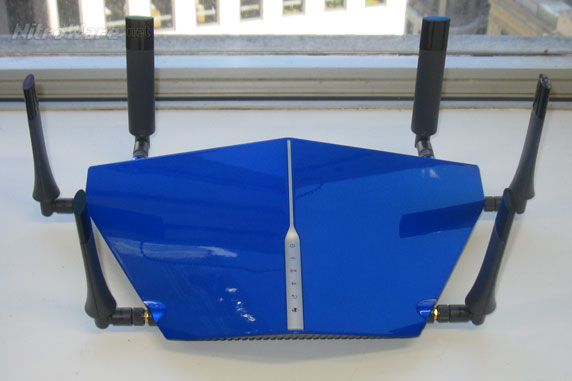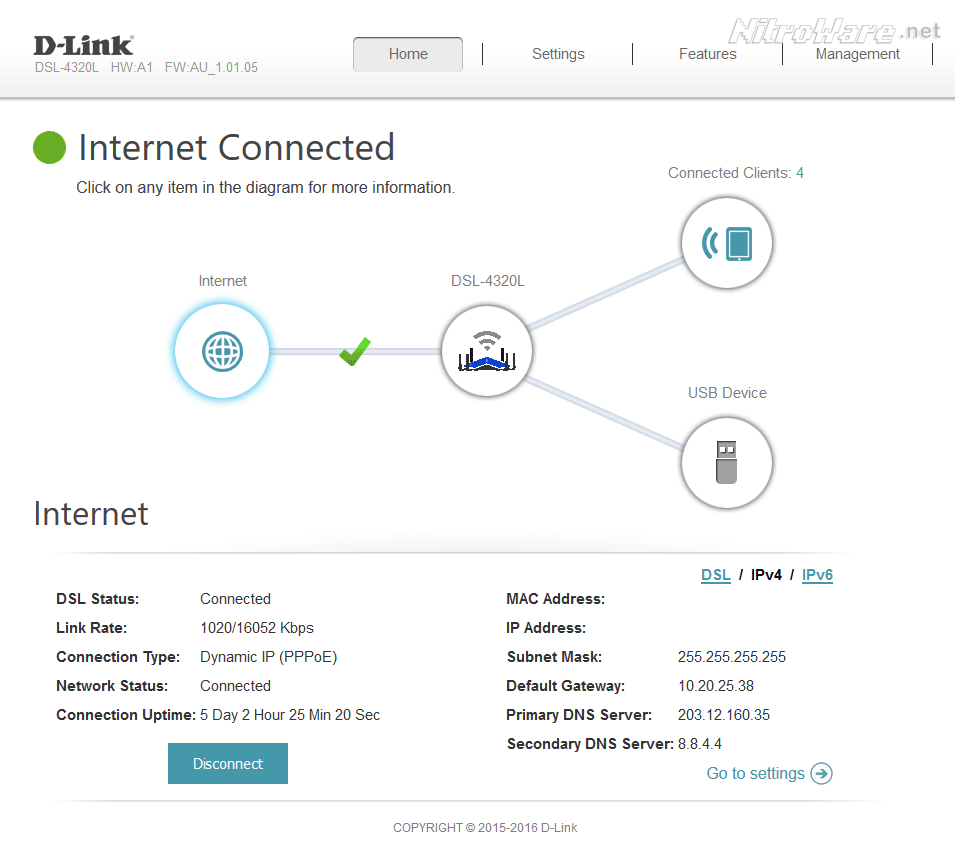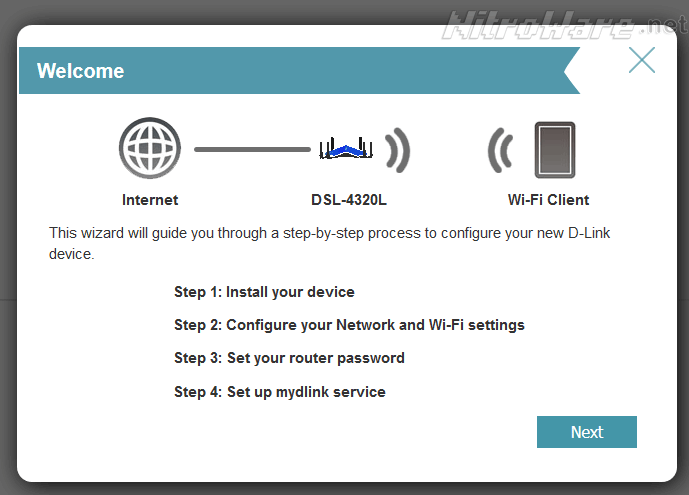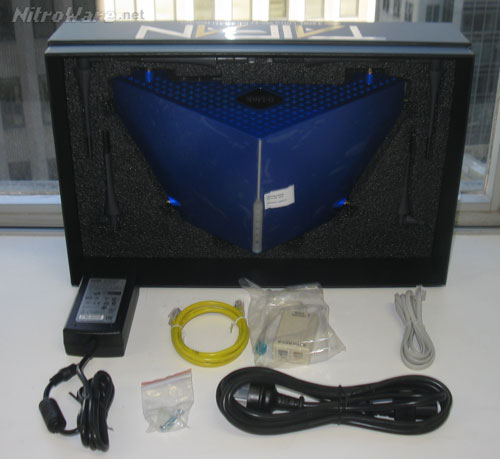"They call it the COBRA" - D-Link’s most bonkers DSL modem router yet.
Here D-Link’s latest flagship networking router is previewed and compared it to its Triple band AC3200 Wi-Fi predecessor the Taipan and competitors from Netgear the Nighthawk X8. The benefit of Triple-Band Wi-Fi is explained as are the basic specs around Wi-Fi speeds and numbers are summarised. Plus we have a look at how both the Cobra and the Taipan work internally.
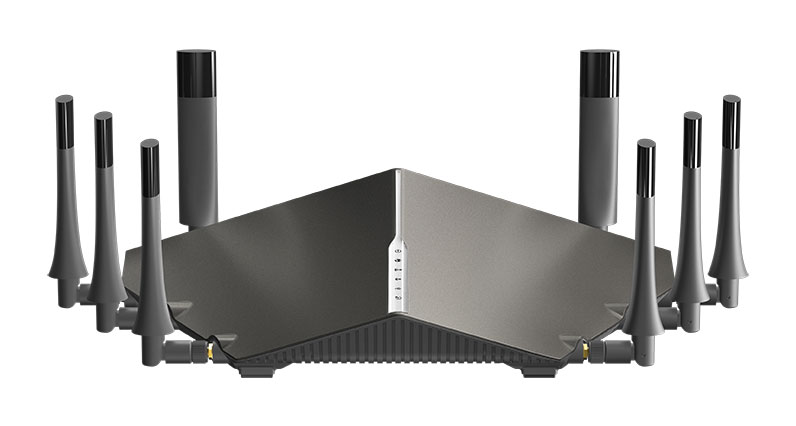
Announced this week is D-Link’s latest flagship DSL modem router (also known as a DSL Gateway) aimed at the early adopters, enthusiast and prosumer audience. This is a very high end unit device not for the faint at heart.
Named Cobra, the DSL-5300 continues the snake themed branding D-Link has applied to its flagship modem routers. 2014 had the DSL-2900AL Viper which was a dual band unit supporting ADSL2+ with AC1900 3x3 Wi-Fi , then we had the DSL-4320L Taipan in late 2015 which was Triple band unit with VDSL2+ and supporting an aggregate of AC3200 Wi-Fi speed over triple brands (600 Mbps for N, 1300 Mbps for 5Ghz AC Band A, 1300 Mbps for 5 GHz AC Band B). Also the AC1600 Python VDSL2 Modem Router
The latest update is the Cobra which enhances the feature set of the Taipan to support MU-MIMO diversity for the Wi-Fi, extra antennas, faster speeds as well as an additional Ethernet port. Also a triple band device, the Cobra now supports 1000 Mbps on 2.4 GHz, and 2167 Mbps both each on 5GHz A and B.
In this article I will compare and contrast these routers, providing an overview of the key differences between them, what to look out for and consider when shopping for a high end modem/router. Since I discuss four triple band Wi-Fi routers, I explain what Triple Band Wi-Fi is and why you may need it. My more technical readers will be interested in the device teardown where I show the main chipsets. For both technical and semi casual audience A summary and overview of Wi-Fi 'speeds and feeds' is provided to help decode the various numbers and acronyms associated with Wi-Fi devices which can be confusing even to those in the networking industry.
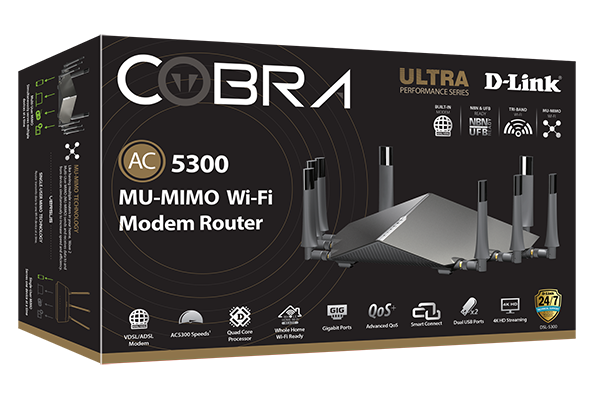
The cure to Wi-Fi dead spots, the strong ARM of the network. If only the COBRA had eight high-gain antennas, he would be even more badass.
What is Triple Band Wi-Fi
Before we get into more feature comparisons between the Taipan, Cobra and their competitor, NETGEAR’s D8500 which offers an almost identical feature set to the DSL-5300 Cobra, I want to talk about what triple band Wi-Fi is and what benefits it brings to the user, as well as how vendors are promoting this feature.
Dual band Wi-Fi is now old hat, being with us for almost 15 years now and serves a critical purpose for those in wireless land, now offering 2.4 GHz and 5 GHz bands simultaneously to end users. Faster speed and more channels (or ‘slots’) are available on the less congested 5 GHz band at the expense of some range. Wi-Fi AC only works on 5 GHz, with AC wireless devices falling back to N for the 2.4 GHz band.
RF Frequency spectrum is a very complex engineering topic and becomes more complex when we add the additional data layers and protocols on top that encapsulate your data when it is sent over a wire or the air, The mess what was ‘greenfield detection’ that was refined in the final standard of Wi-Fi 802.11n (how a Wi-Fi Device can regulate its bandwidth in a congested environment) is not even half of the story.
The short of the matter is, a Wi-Fi Access point can only support a maximum number of simultaneous users whether it is 2.4 or 5 GHz, this is limited by design. There are formulae out there to calculate how many devices can simultaneously work on a Wi-Fi access point based on certain device, wireless network and airtime conditions but I made a decision not to go down that road in this article as I want to present that sort of information in an easier to comprehend method. For those interested, Enterprise networking vendors will typically have such information in their knowledge bases. One such example advanced users can check out is Revolution Wi-Fi™ Capacity Planner spreadsheet from Andrew von Nagy at www.revolutionwifi.net
At first when vendors presented the triple band Wi-Fi router concept to me I thought it was a bit of snake-oil, as what can a router with two 5GHz Wi-Fi radios do better than one? I looked into the subject and I am happy to admit I was wrong.
The vendor’s claims of these triple band units supporting more simultaneously online devices are true and correct, but they add up all the Wi-Fi speeds and advertise an aggregate Wi-Fi speed, such as AC5300 or AC3200. The device can deliver this throughput but it is an aggregate speed of all the wireless radios or access points within the device. Each end user can only connect at the maximum speed their client supports, which in the real world is typically a maximum of 1300 or 1600 Mbps.
D-Link Australia advised us that they see “10-20 connected devices in the home” as benefiting from a higher end router such as the Cobra. In addition the maximum speeds supported are not the overall goal for the device, but abililty to support more devices more reliabilty, especially with applications such as 4K streaming.
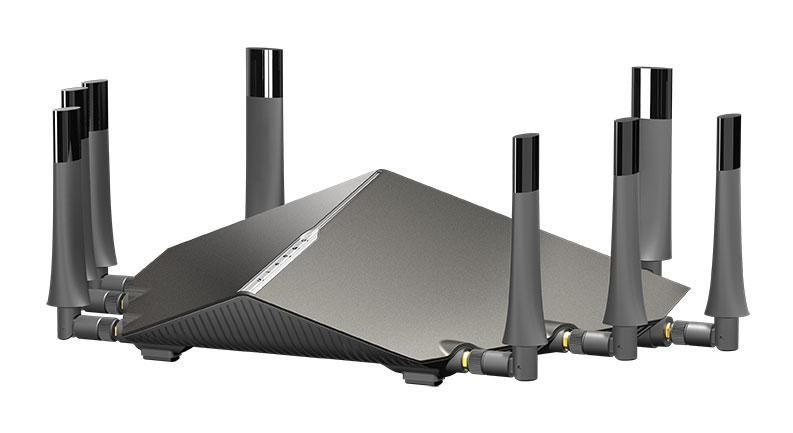
Brand and Model Choice – Decisions, Decisions…
Selecting a brand or model of modem or router is a very touchy and subjective subject for some users.
For general consumers, they will accept whatever their ISP offers, what a retail big box store has or friend/advisor may recommend.
Despite what some enthusiasts/IT experts will try to claim, the quality and feature set of ISP supplied equipment has improved dramatically over the past few years, however lack of firmware updates and locked down settings still apply to these devices. Hopefully one day some difficult users will too notice this sea-change in devices, but progress does still not excuse the ISP from crippling a device for business or financial gain or restricting updates.
Even for high end devices such as 4x4 AC Gateways with USB 3.0, VoIP and DECT connectivity, these ISPs do not provide firmware for public download, they are only pushed through their internal ‘TR-609’ management system. Many power uses deteste this ‘backdoor ‘ and raise their torches and pitchforks - How dare the ISP control my modem! This chant is rightfuly so when a ISP and their equipment supplier do not deliver the same security fixes and product enhancements to their ISP customers compared to their retail devices.
For this market which is the majority of netizens out there, security fixes are more critical for them than say more advanced users who are more knowledgably in securing their network and devices in the interim until a fix is ready. Generally, ISPs simply don’t care more than they currently have to. Their negotiations and interactions with their hardware suppliers are often long, protracted and somewhat difficult. Sometimes software features and support are intertwined with the supply contracts entered into for said devices.
For power users and enthusiasts, every piece of minutiae matters and as such networking vendors aggressively brand their enthusiast devices to that market with flashy names and case designs. Many care about third party firmware support, which is available on devices from NETGEAR and Linksys. Gateways with modems in them are harder to support for third party firmware such as OpenWRT.
Triple band DSL Modem/Router comparison | D-Link v NETGEAR
In this story I will compare and contrast the three main competitors in the triple band DSL Gateway segment. All three devices have overall similar specs, with the Cobra and Nighthawk X8 being closely matched.
2015 - D-Link DSL-4320L Taipan - AC3200 (600+1300+1300 Mbps)
2017 - D-Link DSL-5300 Cobra - AC5300 (1000+2167+2167 Mbps)
2017 - NETGEAR D8500 Nighthawk X8- AC5300 (1000 Mbps + 2167 Mbps + 2167 Mbps)
In addition, to showcase competition I have thrown in the similarly speced but modem-less ASUS competitor router.
2017 - ASUS ROG RAPTURE GT-AC5300 - AC5300 (1000 Mbps + 2167 Mbps + 2167 Mbps)
D-Link and NETGEAR also make AC5300 Triple band router but the focus of this article are combo modem routers/gateways, which are a tier above router only devices in feature and cost.
As of time of writing I have not yet tested either the Cobra or Nighthawk X8 and awaiting our review unit. I was involved in the beta test program for the now lower model Netgear D7800, a VDSL2+ DSL Gateway with AC2600 dual band MU-MIMO Wi-Fi and we did receive a review unit of the D-Link Taipan and have tested it extensively.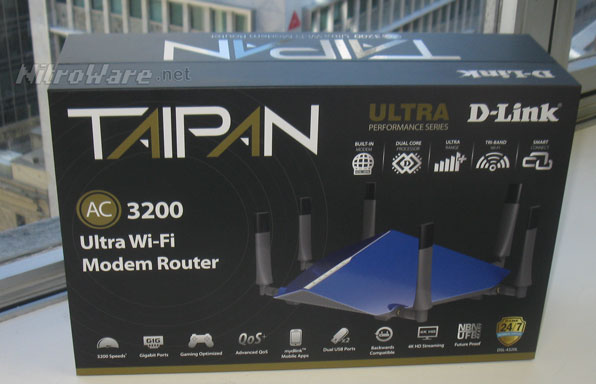
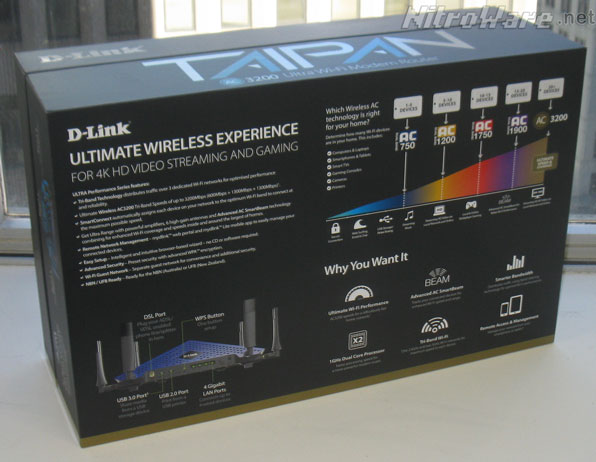
Wi-Fi
Both DSL-5300 and D8500 support triple Wi-Fi bands, each with 4 receive antenna, 4 transmit and 4 streams (4x4:4) an upgrade over the DSL-4320L’s Triple band 3x3:3 config, a setup which premium Dual band AC Wi-Fi has had since introduction in 2012.
D-Link Australia explained to us that despite the COBRA being their “ultimate performer” for W-Fi, an upcoming firmware update will enable it to pair easily with the company’s DAP-1620 AC1200 Wi-Fi Range Extender, enabling the same Wi-Fi credentials to be used on the extender.
D-Link calls this feature their “whole home Wi-Fi” concept and branding, where only the one Wi-Fi SSID is used throughout your house rather than your devices roaming between different Wi-Fi access points.
When we consider that D-Link and some other brands now also feature one SSID name for all three Wi-Fi bands, where the right band will be selected depending on client support and load, these features combined make eliminating dead spots and enabling Wi-Fi for larger premises easier than in the past. Advanced users can turn off single SSID and have their traditional separate SSIDs for each band.
D-Link Cobra uses 8 ‘high gain’ antenna. One 2.4GHz and one 5GHz Radio share one set of four antenna, the other 5GHz Radio uses the other four antenna. I am not exactly sure why this design is used but given simultaneous dual band 2.4/5 GHz has been a thing for a few years now on routers/access points and clients with as few as 2 antennas, it should not be an issue here.
Netgear uses this format but on recent modems switched to a unique design for their recent flagships, “active antennas”, somewhat a buzzword actually when considering a router. #buzzwordbingo
On newer router designs, the Wi-Fi radios are connected by the PCI Express bus to the main processor, just like the Wi-Fi card in your desktop or laptop. An amplifier boosts the signal for each antenna and is connected to an internal or external antenna, so you can have working Wi-Fi. Each of these modules are shielded from interference from each other and the outside.
Active antenna in the NETGEAR Examples is they have moved more of the RF front end circuitry into the antenna housing itself. They claim this offers better performance, less interference by moving the circuits out of the ‘noisy’ router and other shenanigans. The mainboard can be made smaller but the antennas lose some ability to be positioned. Plus you are in trouble if you break an antenna, were as a regular antenna can be fixed relatively easily. It is more expensive to do this the latter way for less return. The majority of Wi-Fi access points are not designed this way including enterprise models so for now this is a niche gimmick feature.
Buzzword bingo rings true here because in the traditional sense, any antenna design which uses an amplifier to boost the signal is classified as 'active'. Under this classification many hundreds of older routers can also be classed as having active antenna, in the traditional sense of the term.
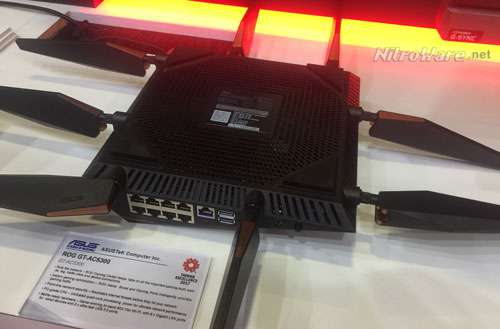
An important note on Wi-Fi speeds.
Standard Wi-Fi speeds for AC devices which support 3x3:3 are 450 Mbps on 2.4 GHz and 1300 Mbps on 5 GHz. Many but not most PCs and Wi-Fi devices in the market can connect at these maximum speeds. Macbook Pro is an example, which have Broadcom Wi-Fi that supports 3x3:3.
We noted the Cobra and Nighthawk support 1000Mbps on 2.4 and 2133 Mbps 5GHz. To reach these speeds you need two things on your client device, first your Wi-Fi adapter has to support 4x4:4 antenna:stream config and it has to support advanced form of modulation called 1024QAM. Some high end desktop Wi-Fi adapters support these features but they are relatively uncommon. Without this, the maximum speeds are 1300Mbps or 1732Mbps
Traditionally, Wi-Fi access point speeds have always outpaced client adapter specs even for Wi-Fi N, despite using the same technology. There are many and different excuses on why this is the case from vendors.
From what I have seen, the most commonly available add-on Wi-Fi adapters in USB or PCI Express card support an aggregate speed of ‘only’ AC1900, which is an aggregate of 600Mbps for connected 802.11n devices and 1300Mbps for 802.11ac devices such as what’s supported by D-Link’s DWA-192 USB adapter and ASUS’s USB and PCE-AC68 PCI adapter.
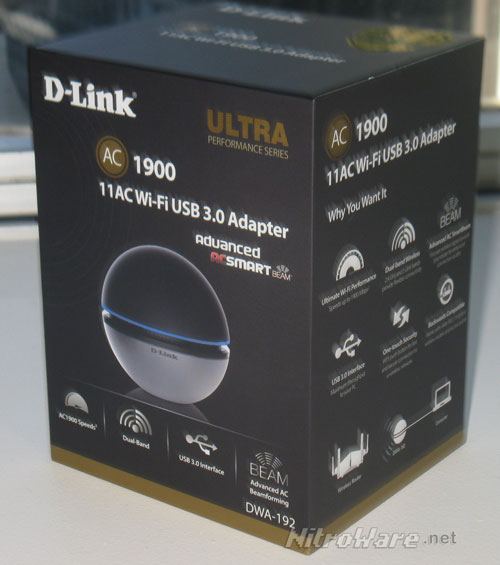
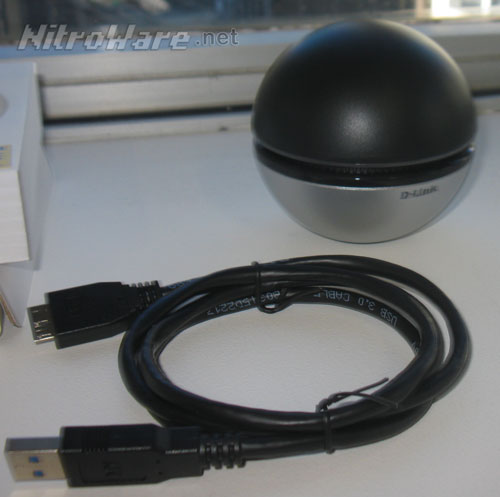
ASUS’s PCE-AC88 PCIe adapter uses the same 4x4:4 Broadcom MU-MIMO BCM4366 Wi-Fi chip as the routers discussed here plus 1024QAM modulation so can connect up to 1000Mbps on 2.4 and 2167Mbps on 5GHz. This card is meant for desktop PCs and I am not yet aware of any laptop or even a notebook Wi-Fi card that supports such Wi-Fi speeds.
Even if such a USB adapter is available, such are often cumbersome and may use an external antenna array.
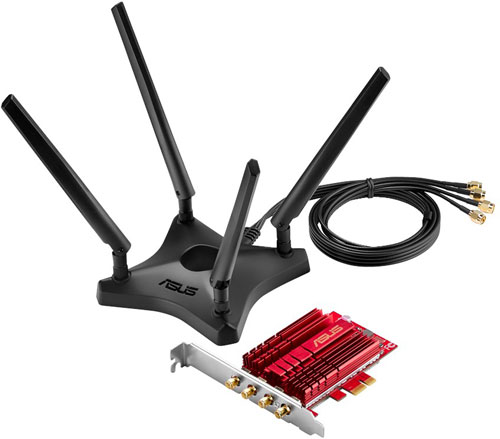
Wi-Fi specs and speeds summarised
The speeds and feeds for wi-fi AC we have discussed here can confusing compared to older and simplier devices such as 802.11g or n. The following should help clarify the bewildering combinations of frequencies, streams, speeds and antennas.
Background
-
The advertised Wi-Fi speed your PC, Router or Adapter supports is calculated based on the number of data streams the device can handle to each device and how much Radio Frequency bandwidth is avalible. This gives a link speed in Megabits per second (Mbps). This is the number you will see advertised on products and in software.
-
The link speed is the overall data rate, not the speed at which you will download or upload files. Wireless technologies have large overheads. For example, an AC 1300Mbps Wi-Fi connection with a strong signal will give the user an actual file transfer speed of around 600-700 Mbps.
-
Wireless Radio Spectrum is divided into channels, just like your TV. Each channel has an equal bandwidth starting with 20 MHz. The 'width' can be increased to 40 for Wi-Fi N by using two channels. AC uses 80 and 160 MHz. How channels are bonded together and which channels are for which country is for another topic.
-
n can operate on either 2.4 or 5 GHz radio bands, ac runs on 5 GHz only. There are more channels avalible in the lesser regulated and occupied 5 GHz spectrum so wider channels chan be used, which means more bandwidth and speed
- Typically, each 'spatial stream' is connected to its own antenna but this doesnt have to be the case. The device will switch each antenna between transmit and recive mode when it needs to.
- Check the device's box for detailed Wi-Fi specs
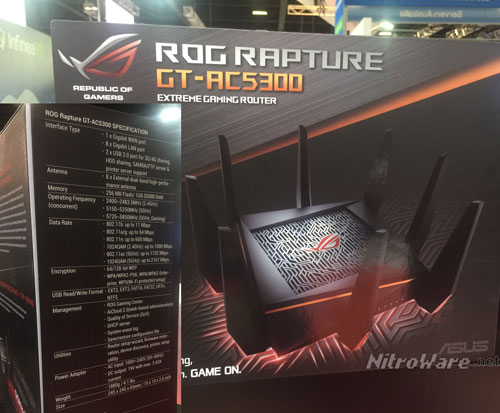
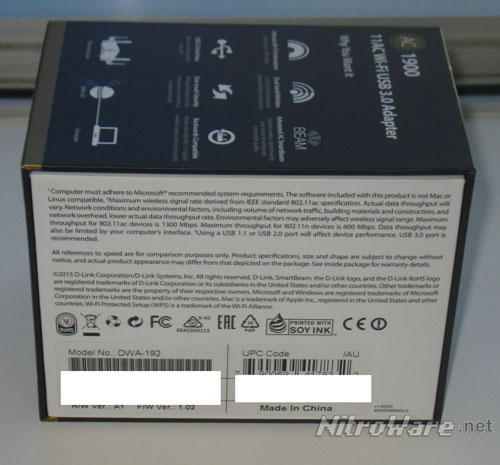
Wi-Fi n Basics
-
The basic speed for a single 20 MHz Wi-Fi 'data stream' is 65 or 72 Mbps for Wi-Fi n depending on the device. Older Entry level Desktop, Notebooks, phones and other devices will typically have a wi-fi adapter of either speed depending on age and type. You will see this number in your software or in the device specifications. Wi-Fi N can use 40 MHz wide channels to double the avalible bandwidth/data rate to 150 Mbps per stream
-
Most routers/acess points use 2 streams and higher end models 3 streams, using two or three antennas.
-
A N 300 router or adapter uses two streams to acheive the advertised 300 speed. a N 450 device uses 3 streams. Some devices allow this maximum speed on 2.4GHz, some 5GHz only.
-
The new routers mentioned in this story support 600 or 1000 Mbps for N devices. 600 is acheived with 4 streams, 1000 with '1024QAM' modulation.
Wi-Fi ac Basics
-
The basic speed for a Wi-Fi ac stream is 433 Mbps acheived using a 80 MHz wide channel in the 5 GHz range. Newer Entry level Desktop, Notebooks, phones and other devices will typically have a wi-fi adapter of either speed depending on age and type.
-
ac devices support both n speeds and ac speeds. The advertised speed is a combination of both, such as "AC750", "AC1200", or "AC5300", there are numerous combinations.
-
AC1200 devices are likely the most common when considering the routers, PCs and notebooks. An AC1200 device supports 300 Mbps for n devices and 867 for ac devices, which together rounds up to 1200.
-
867 Mbps on AC is acheived using 2 transmit antenna, 2 recive and 2 433 Mbps spatial streams of 80 MHz width each, giving us 867 Mbps to use on the 5Ghz band. This is represented using the following notation 2x2:2
-
AC1750 devices support 450 for 11n (3 streams) and 1300 on 11ac (3 streams, with 3 antennas)
-
In this story we have devices supporting 2167 Mbps AC using 4 80 MHz streams. How is this possible when 4x 433 is 1732? The vendors advertise 1024-QAM modulation feature as being required for an adapter or PC to support 2167 Mbps using the routers we have covered in this article.
Ethernet/Wired Networking
Things are straight forward here. The Broadcom BCM47xx (codenamed Northstar) family of chipsets has five port integrated Gigabit switch which D-Link utilise.
NETGEAR D8500 Modem/Router has 7 total Gigabit LAN port inc 1 WAN port, and ASUS’s ROG RAPTURE AC5300 router has Nine Gigabit LAN ports inc 1 WAN port! The extra port is typically lost for the added on DSL modem feature or is shared with another port.
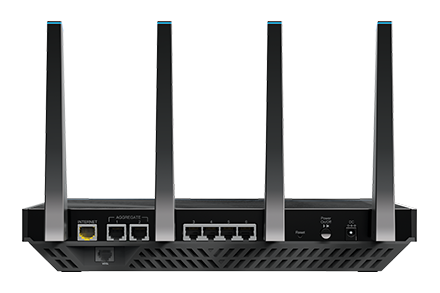
8 ports is a reasonable request in 2018 for an A$500+ unit but let’s look at why it is not the case, software engineering, component count and board size, power, and cost. Despite 8 port GigE switches being cheap to buy standalone, sticking one into a consumer router requires engineering effort and cost. It can be done however and has been done with the above devices with an extra switch chip. Software wise if you have eight ports, Virtual LAN support must work for each port, as well as Quality of Service and if applicable any special support for voice or TV services connected to a specific LAN port.
Following on, Netgear and ASUS support port aggregation which bond two of the Gigabit LAN ports together for connection to a dual port NAS or server, not supported on D-Link, again a desirable feature for a router which has a number of simultaneous users. ASUS supports the same, as well as as a pair of prioritised ports for lower latency gaming.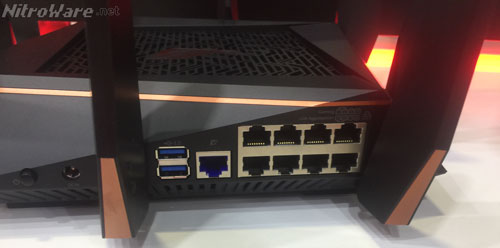
D-link clearly advertises support for ‘Green Ethernet’. This is a hardware of the chipset platform they have selected that reduces the amount of power used to drive each LAN port. This feature may be supported by other vendors, but its pot luck if it works and often is not advertised by them. Intel’s Networking Drivers will indicate if this feature is active.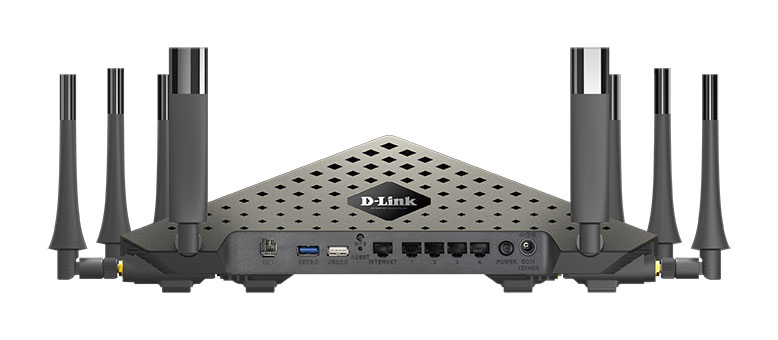
Chipsets
The way these high end routers are designed is that the Wi-Fi (and DSL modem if it’s a DSL gateway) are separate devices to the main processor. Therefore the manufacturer can reuse the same processor for multiple designs and change or update the wireless radios when needed.
The typical architecture for Broadcom and other competitors now such as Qualcomm, Quantenna, Realtek and others is the main SoC (system on a chip) contains a multi core ARM processor, 5 port Gigabit switch, PCIe Controllers, USB3 controllers and Network Engines or Offload Processors which are intended to process specific network operations or traffic within a hardware accelerator rather than run them on the main CPU, freeing CPU cycles for other tasks.
Note I said routers, for this class of device the DSL modem is a separate device, either physically connected by a cable or integrated onto the mainboard connected to the main processor via a bus, typically Ethernet but others buses are possible.
Cheaper DSL gateways, such as the physically smaller and cheaper wireless N or AC types supplied by your ISP or purchased in retail use an all in one design chipset with much weaker CPU cores. The processing power isn’t needed on those devices.
D-Link’s Cobra uses Broadcom’s BCM4908 as does the ASUS Rapture. This chipset has a 1.8GHz quad core 64bit ARM Cortex-A53 processor; Wi-Fi, QoS, routing, USB and Security acceleration; a 2.5Gbit WAN port (but this may not be enabled in the Cobra), USB 3 and three PCIe Gen 2 links to connect to the three Wi-Fi Radios being Broadcom’s BCM4366 4x4 802.11ac MU-MIMO Wi-Fi enabling the tri-band support for the device
The Taipan used Broadcom’s BCM4708/9 with Dual Cortex –A9 at 1GHz, which had similar features, paired with Broadcom’s BCM63381 VDSL2+ modem chip. Core wise, each of the 802.11AC Wi-Fi radios have a smaller embedded class ARM core.
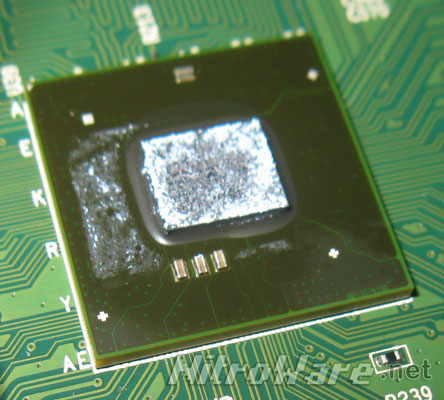
Broadcom likes to add up the sum clock speed of all the processors on its platform in their marketing, four ARM CPU cores and one each for the three Wi-Fi radios but this is a form of cloud washing, as the CPUs in the radios do not provide a direct benefit to the user and are there working in the background running part of your Wi-Fi traffic basically. Fortunately Networking vendors like D-Link just advertise the main CPU core count and clock speed and do not try to push any funny business onto the user in this regard.
In a router, operating system or firmware runs on the main CPU cores providing services such as NAT, routing and other essential networking, higher level security services, higher level Wi-Fi services and user convenience features such as USB drive sharing, printer sharing, DLNA media server and cloud services such as cloud access. Any low level processing of networking packets is done in hardware accelerators such as with contemporary network interface cards in a desktop or laptop. Modern chipsets such as the one in the Cobra also have a hardware security processor to offload VPN and Wi-Fi encryption from the CPU.
Since networking chipsets have hardware packet accelerators or IP engines, comparing raw performance them to similar chips used in mobile phones or even desktops gets complicated.
I can provide a simple and quick benchmark comparison to show what difference the CPU cores in a networking device can bring to the end user by testing USB drive sharing. Note these results are also affected by the tuning of the configuration and software load on the networking device.
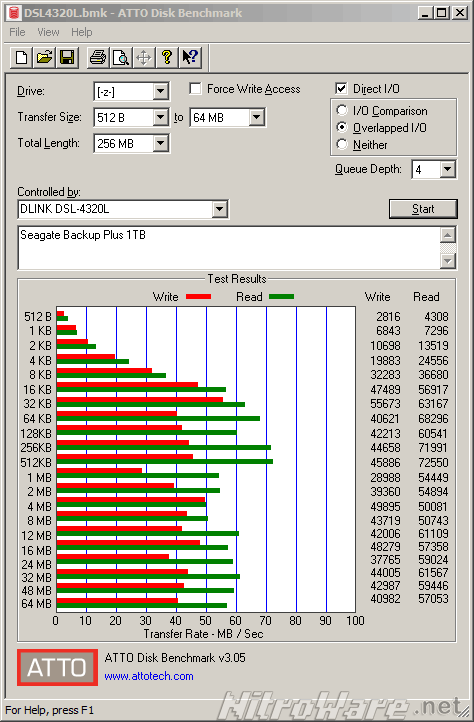
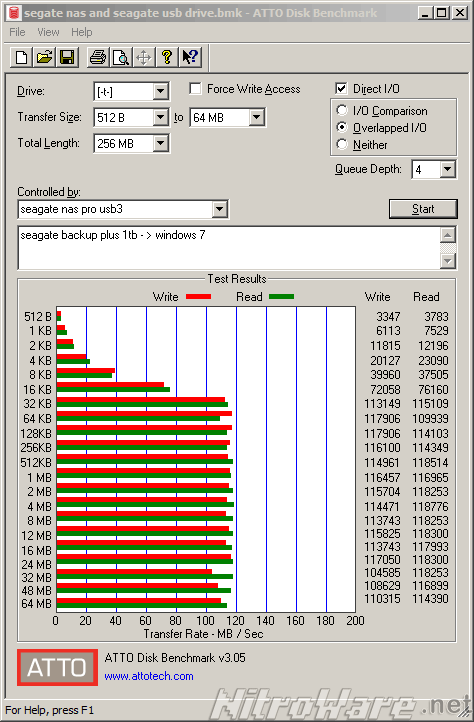
The D-Link unit actually only supports the now insecure SMBv1 file sharing protocol, while Seagate has up to date software and is powered by the Dual–Core Intel Atom CPU C2338 @ 1.74GHz. This CPU is part of Intel’s Rangeley family of networking processors.
Since we used a NTFS formatted drive, the CPU must handle all the file system processing tasks itself and this cannot be hardware accelerated.
When a vendor comes to update their chipset, it makes sense to update the CPU cores to the latest tech even if it absolutely not needed for the application. Newer features, power saving and of course performance is all appreciated, and provides both manufacturer and end user ‘reasons’ to buy or upgrade.
Comparing apples to oranges, and taking into account the different software load and configuration we can see two different CPU platforms offer different performance for a simple task such as a NTFS formatted USB 3.0 drive sharing over a network.
While 70MB/s on D-Link is GOOD, Seagate’s result is better and is almost identical to plugging the drive direct into the PC. So hopefully we will see a significant user benefit with the Cobra’s better CPU.
Internals and Tear-down – How the D-Link DSL-4320L Taipan works
Both the Taipan and Cobra use the same casing plus D-Link has a strong relationship with Broadcom, using their designs and parts for their products top to bottom so other than an update of the internal chipsets I don’t anticipate much changed between the devices.
I have illustrated the logical function blocks on the Taipan main board and we can see the main chipsets that provide each function as well as the requisite RAM and Flash memory. As Mentioned earlier, the Cobra will be a very similar design updated for newer chipsets, a different port layout and 8 instead of 6 antenna.
This diagram should give technically minded readers a better understanding of what’s inside a triple band router and how it works as well as where all the cost goes into this class of device.
The DSL modem chipset is connected to the main processor via Ethernet and each of the three radios are connected by PCI express through the PCIe switch.
RF shielding was removed for photography purposes as well as a heat-sink plate which covered all of the RF cans, another of which was under the PCB as well.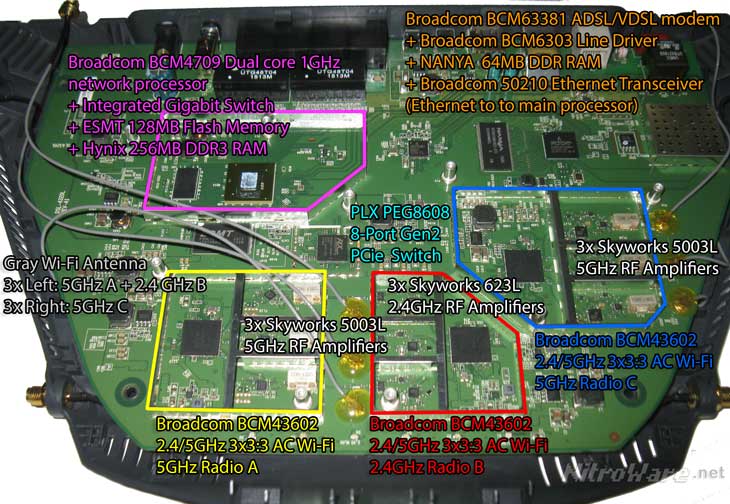
Like your PC, a high end router is fitted with a large amount of memory to accomodate the Linux operating system they run. The Taipan had 256 MB, the D7800 512 MB and the ASUS Rapture has 1 GB. To some vendors this is used as a marketing tool, ie more ram is better. If one actually looks at the memory usage on their device however the higher amounts are not actually needed.
Firmware and Software
D-Link provides a more generalised firmware with options for advanced users such as DHCP override parameters, multiple PVC (virtual circuits) for DSL connections where IPTV and voice services are available, and the ability to configure advance settings for the DSL modem component. Such settings are not available on most NETGEAR devices as their Modus Operandi for the past 15yrs has been to design their user interfaces in a very consumer and user friendly way.
D-Link have improved their UI significantly in recent years but ask anyone who has had to support their older device produced until say 2013 on their opinion of the interface, as it was geared more towards advanced users.
D-Link clearly advertises VLAN tagging for NBN/high speed broadband services also. This is purely a software feature, and is an aspect where each networking vendor differentiates.
Connecting a consumer premise device (CPE, i.e. your home router) to the Australian National Broadband Network is not as simple as just having a device with the right port. Certain firmware parameters are required depending on which NBN reseller you have signed up to, and even then there are settings for Voice and TV services which not all brands and devices have exposed.
Power users consider third party firmware support when purchasing a high end device and which there is some support for Broadcom 5GHz AC Wi-Fi via a number of different Broadcom Linux driver projects, the DSL modem is unsupported, so the point here is why are you buying this device to put third party software on it in the first place, if you must, there are other similar devices without the modem.
D-Link's mycloud feature which allows basic settings to be remotely configured through D-Link's website regardless plus their 'whole home wi-fi' support which replicates Wi-Fi name and credentials to extenders are coming in a future firmware update for the Cobra, I have used D-Link mycloud site and mobile apps for D-Link routers and to access D-Link IP cameras and found them easy to use, more so their mobile apps and preferable over Netgear's cloud and mobile software.
There are security implications with any of these solutions but these should not be the primary decision maker for you. If you are allergic to vendor cloud solutions simply turn them off they are not mandatory.
Industrial Design and accessories
Netgear have delivered a more compact and slimline case, resembling a traditional boxy wide set stop box. It is a departure from the F-117A Nighthawk styled devices that Netgear has marked for the past few years. I am not sure exactly why this one is the odd one out from the rest of the Nighthawk family of gateway, routers and switches.
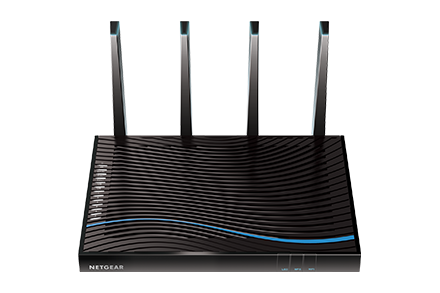
D-Link bundles wall mount screws with the models that use the same casing as the taipan/cobra an appreciated feature. This is a large device for many shelves and desks.
Both D-Link bundle a DSL-008 ADSL2+ filter and phone cord for the Australian market as does Netgear also bundle a filter.
D-Link use an in-line type 65 watt power supply brick that has a detachable power cord on the Taipan and Cobra. Netgear use large plugpacks and ASUS use a 'standard' 19V 65W laptop adadpter which makes replaceing the router's power supply relatively cheap and easy if it is damaged or lost. Why is this important? Simple. A wide or large power plug may conflict with power plugs or furniture. D-Link and ASUS's bricks is a bit more flexible.
Warranty is very important to me as both a reviewer and power user. To all vendors, one year warranty is not acceptable for a flagship networking device in the $500-750 AUD range. I am be happier with two to three years. These devices won’t be thrown out by users any time soon and they expect them to work forever. D-Link Cobra comes with up to three years warranty for ANZ, registration for the 3rd year. NETGEAR offers 2 years for ANZ and ASUS, well I had to google it! ASUS website lists 'check region' and some AU resellers state 3 years. Given the ASUS is the most expensive device of the entire bunch mentioned here it having three years/no modem and the others having 2-3 does not really change the status quo. The Cobra has a good warranty so I am satisfied. So warranty wise things are covered here plus for Australian users D-Link do have local support. In the past I have had a DSL modem router re-flashed by their local office with quick turnaround.
Recommendation and Verdict
Choose between two similar devices? Flip a coin if u can’t make your mind up.
As of staticice price matching engine on week 4 of NOV-2017, the low street price for the D8500 was $590 AUD, the just introduced DSL-5300 $A620 AUD (RRP A$749). D-Link Taipan A$460 and the ASUS Rapture A$670
Some power users may balk at this price, and refuse under all circumstances to accept this is a thing but you get what you pay for. That Is the technical cost of putting three radios, PCI switch and a modem in a single box. You will add up to a similar price if you did it yourself using Two or Three physical access points, a software or hardware WLAN controller, a DSL modem and a Ethernet switch, plus all the time money and wasted space electricity setting all that stuff up. Vendors such as Ubiquiti, Extreme Networks or Aerohive will happy take your money for such a setup. If we look at the D-Link devices as illustrated, the PCIe switch chip is A$50 alone!
The Netgear offers more Ethernet ports for a lower price, but that may just be a factor of being in the Australian market longer.
To some users the lack of LAN ports on a given device may not be a big deal as they may have a switch or older device to connect, or they are simply use Wi-Fi heavily, For some people a wired connection to their PC is not possible to due to the construction of their home or office plus wireless is seen as trendier, despite offering a poorer user experience over wire.
I am pleased D-Link fixed the shortcomings of the Taipan, but really the Cobra is a year late given the hardware platform was announced at CES 2016 and IMO Taipan should never have shipped without MU-MIMO. Not long after the Taipan was released in ANZ, a 'snake' series router was released with MU-MIMO support plus the Taipan using older chipsets meant it was not firmware upgradeable to recive that Multi User-MIMO support
I was not entirely pleased with the older Taipan when we got it in for review. The finish of the blue paintjob was remarkable but having four LAN ports instead of five and no MU-MIMO or enhanced Wi-Fi speeds above AC 1300 for a device of that class and price did not sit well with me. For a while I kept alternating my home connection between the Netgear D7800 (AC2600 MU-MIMO) and the D-Link 4320L Taipan and I eventually settled on the Netgear for the long term, despite its semi broken IPTV support. The triple band Wi-Fi did not give me any advantages for a small number of connected devices. The Cobra fixes this but at a high $RRP.
D-Link offers more advanced features in their firmware, can be counted on for working IPTV support. Some sensitive, touchy enthusiasts may not like the radical design of the Cobra. The Netgear has more LAN ports and port aggregation, for connecting things like a NAS or server plus a more conservative industrial design. The CPU differences even out.
Active antennas I cannot comment on other than from theoretical and implementation perspectives. Sites like Smallnetbuilder provide more scientific analysis on actual Wi-Fi performance.
These devices are for those who need the best of the best, even the majority of enthusiasts and power users are well suited with just a dual band MU-MIMO device. But vendors offer choice and often feel they need to emulate each other based on perceived, sometimes false market demands.
The newest buzzword in the home networking market is mesh Wi-Fi, or whole-home Wi-Fi - a series of access points connected to each other spread across your dwelling that is supposed to eliminate the black spots that are the caveat of a traditional Wi-Fi ‘box’.
Neither device mentioned here supports mesh networking as a master device. ASUS advised us that they will be issuing a firmware update https://www.asus.com/aimesh/ for their router series to enable mesh network on their end, meanwhile Netgear, D-Link, Linksys and a few others sell standalone mesh networking kits for home use that are independent of an enthusiast grade networking device such as the Cobra or Nighthawk.
D-Link will support a single SSID through your network, ‘whole home wi-fi’ if the appropriate firmware and access point is used, a handy feature.
If you do not need an integrated modem, D-Link, Netgear and ASUS do have subsituite models –
- The D-Link DSL-4320L Taipan is based on the DIR-890L Triple band AC3200 router
- The D-Link DSL-5300 Cobra is based on the DIR-895L Triple band AC5300 router but using newer quad core 64bit processor.
- Netgear’s D8500 is based on their R8500 Triple brand AC5300 router, both looking identical.
- Several high end AC5300 offerings from ASUS.
Like its processor, this D-Link gateway is late to market compared to its competitor. If D-Link made a device that was feature equivalent or superior to the Netgear in all its hardware bullet points, I would choose this theoretical D-Link device over Netgear due to its additional firmware options. But that’s just me as I am personally biased to more LAN ports on high end devices. My job as a reviewer is to highlight the differences between products and their performance, some user’s minds may have been already been made up, especially at the price these routers sell for.
Overall a good effort from D-Link using one of the latest processors and AC Wi-Fi standards available. Power users your saviour is here, the COBRA will bring you back from the bad side of networking.
